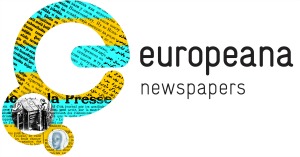The Europeana Newspapers Information Day at the National Library of Estonia (NLE) took place on the 15th of October 2014 and was attended by nearly 90 people, among them local journalists, historians, researchers, librarians, university teachers and lecturers.
The day was publicised via a press release, activity on social media and a leaflet in Estonian. Additionally, an eight-page newspaper was put together by the ENP project team, using the content from old newspapers.
Just prior to the Information Day, the NLE was able to import 100,000 pages of newspaper content into its local newspaper portal dea.digar.ee. At the same time, 48,464 pages of Estonian content were imported to the Europeana Newspapers project’s own content browser. This meant that plenty of issues were available to show people at the Information Day.
Besides introducing the content itself, the audience was also informed about the project itself, the technical background such as why it is important to digitise historic newspapers (eg. poor condition, microfilming problems) and how these factors influence the result of techniques such as Optical Character Recognition (OCR) and Optical Layout Recognition (OLR).
All of the talks contributed towards the four main objectives of the Information Day, which were to:
- Increase the overall awareness of the Europeana Newspapers project;
- Raise interest in historic newspapers in general;
- Introduce the availability and free access of the project’s results in the NLE’s local newspaper portal, in the project’s content browser and on Europeana;
- Promote the importance of digitisation, explain the techniques of OCR and OLR, to find volunteers to contribute via crowdsourcing (correcting the text after automated OCR while reading the old newspapers).
A well-known and very popular voice from Estonian Broadcasting News editorial, Märt Treier, was asked to moderate the event. The day was opened by the NLE’s Director General, Janne Andresoo.
The first speaker, Kristel Veimann — project manager of NLE’s newspapers portal and team member of the Europeana Newspapers project — spoke about the newspaper collection, digitisation process, the current situation and future plans related to the NLE’s own newspapers portal.
The second speaker was Ragne Kõuts, Scientist, Professor of University of Tartu, Faculty of Social Sciences and Education (Journalism, Communication Management). The presentation was titled Newspapers – to whom and why?
The third presentation —Newspapers and Family History Research — was about the issues of genealogists. Presented by Fred Puss, Researcher and Head of the Estonian Biographical Center.
The fourth presentation — Newspapers’ Role: From Early Patriotic Mind, the Estonian Age of Awakening to the Aspiration of National Statehood — was from one of the most well known people in Estonian journalism, Krista Aru. Krista Aru is someone who is always eagerly anticipated as a speaker, so it was an honour to have her at this Information Day.
The fifth presentation was made by the historian Aadu Must and was entitled Hidden Treasures Coming Out from Digitised Newspapers.
Krista Kiisa, project manager of the Europeana Newspapers project within the NLE, gave an overview about the objectives of the project, revealed technical details and explained the partners’ tasks and workflow of the project. Guidance was also given about where and how users could search European newspapers in The Europeana Library portal and in Europeana.
After the Europeana Newspapers presentation, an active discussion took place on the topic of how newspapers in different languages could be made understandable to other language-speakers, including the role of tools such as Google-translate in helping readers with this task.
The Information Day finished with a 10-minute long movie, dedicated to newspapers and made by the NLE’s Digitisation Department. That was followed by an excursion to Digitisation Department, where a live demonstration of the scanning, processing, OCR and segmentation of newspapers was given.
Most of the audience had no or very few information about the resources available in TEL and Europeana before the event and the need for such a day was obvious. Even an hour after the official end of the event, there were still people in the coffee corner, vividly discussing the issues related to newspapers!
